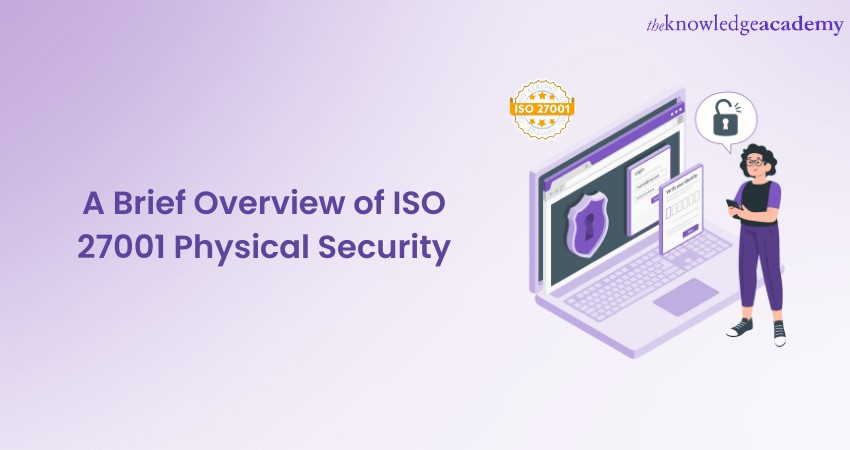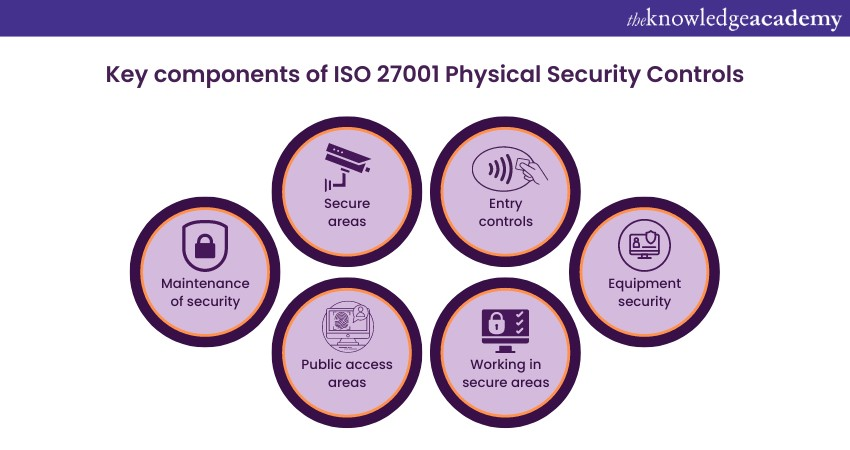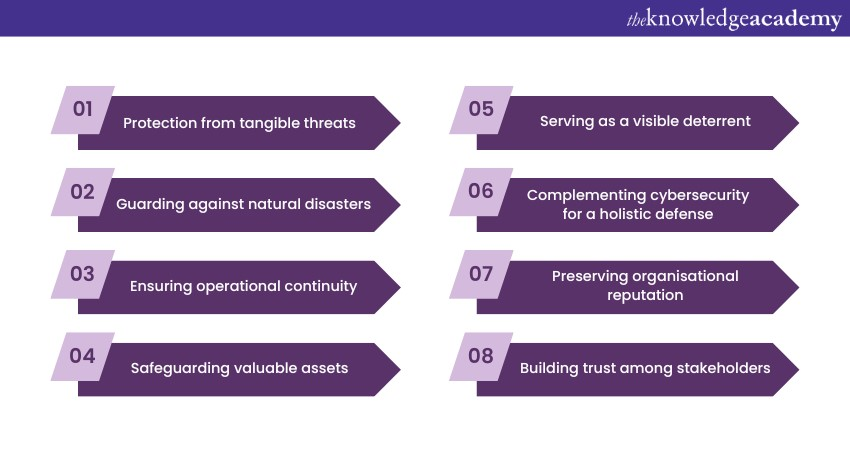We may not have the course you’re looking for. If you enquire or give us a call on + 1-866 272 8822 and speak to our training experts, we may still be able to help with your training requirements.
Training Outcomes Within Your Budget!
We ensure quality, budget-alignment, and timely delivery by our expert instructors.

ISO 27001 is recognised around the world as the standard for Information Security Management (ISM), which emphasises not only on the electronic and procedural aspects of data protection but also on the tangible, physical security of information assets. The term ISO 27001 Physical Security refers to the measures an organisation takes to protect its hardware, personnel, and infrastructure from physical threats.
It is about ensuring that an organisation's tangible assets (like its buildings, equipment, and servers) are equally shielded against threats. ISO 27001 emphasises the significance of both digital and physical controls to guarantee the complete security of information assets. In this blog, you will get a comprehensive overview of ISO 27001, its key components, importance and the steps required for implementing it.
Table of Contents
1) Key components of ISO 27001 Physical Security Controls
2) The importance of implementing Physical Security Controls
3) Steps to implementing ISO 27001 Physical Security Controls
4) Conclusion
Key components of ISO 27001 Physical Security Controls
ISO 27001 key features for Physical Security is comprehensive, ensuring that every potential point of vulnerability is addressed, thereby maintaining the sanctity and safety of an organisation's critical information and infrastructure. Here are some of its key components:

a) Secure areas: This goes beyond just locked doors. Establishing security perimeters often involves multi-faceted measures such as surveillance cameras, intrusion detection systems, and even security personnel. This ensures that sensitive areas are well-guarded against unauthorised access and potential threats.
b) Entry controls: One of the primary defences against physical breaches, entry controls use mechanisms like biometric access systems, magnetic card readers, and security tokens to ensure only authorised individuals can enter certain areas, particularly those holding sensitive information.
c) Equipment security: It's crucial to protect physical assets from theft, damage, or compromise. This means securing storage rooms, using tamper-evident seals, having proper disposal mechanisms for obsolete equipment, and providing secure mounting racks for servers.
d) Working in secure areas: Creating protocols for those working in sensitive areas ensures that security isn't compromised. This could involve policies like mandatory screen locks when workstations are unattended or rules about not leaving sensitive documents on desks.
e) Public access areas: Areas like reception, delivery, and loading zones require special attention since they might be more accessible to outsiders. Effective surveillance, visitor logs, and restricted movement can counteract potential vulnerabilities.
f) Maintenance of security: It’s not enough to just implement security measures; they must be regularly reviewed and maintained. This includes checking the functionality of security systems, updating access rights, or even routine inspections.
Unlock robust security practices with the ISO 27001 Certification!
The importance of implementing Physical Security Controls
Physical Security Controls are not just about guarding tangible assets; they're about preserving an organisation's reputation, ensuring its operational continuity, and instilling trust among clients and stakeholders. ISO 27001 Requirement points will help you to understand the importance of implementing it:

a) Tangible threats: While cyber threats are evolving rapidly, tangible threats such as theft, vandalism, or even espionage have not diminished. Unauthorised personnel accessing servers can potentially cause as much damage as a hacker breaking into a network.
b) Natural disasters and environmental factors: Physical Controls play a crucial role in protecting organisations from natural calamities like floods, fires, or earthquakes. Measures like fire suppression systems, water leak detectors, and climate-controlled environments ensure continuity and prevent data loss.
c) Operational continuity: Any disruption, whether due to equipment malfunctions or unauthorised access, can disrupt business operations. Physical controls safeguard against such disruptions, ensuring seamless operational continuity.
d) Asset protection: Beyond data, businesses have valuable physical assets, from devices to documents. Secured storage areas, surveillance systems, and robust access controls prevent asset theft or tampering.
e) Deterrent effect: Visible Physical Security measures act as deterrents. The mere presence of security personnel, cameras, and access controls can dissuade potential malicious actors from attempting a breach.
f) Holistic security posture: For a comprehensive security approach, cyber and physical security should go together. Overlooking one can lead to vulnerabilities in the other.
Dive deep into security standards with ISO 27001 Foundation Training!
Steps to implementing ISO 27001 Physical Security Controls
Here are some steps to implementing ISO 27001 Physical Security Controls mentioned below:
a) Risk assessment: Begin by identifying potential risks to your physical assets. This involves evaluating locations, identifying vulnerabilities (like access points), and assessing the likelihood and impact of possible threats.
b) Define security perimeters: Establish boundaries around sensitive areas such as server rooms or data centres. These boundaries will help in creating clear zones that require specific security measures.
c) Design entry controls: Depending on the assessed risks, determine the types of access controls required. This might range from basic keycard access to more sophisticated biometric systems.
d) Install surveillance systems: Equip key areas with surveillance cameras and intrusion detection systems. Regularly monitor and maintain these systems to ensure they are always operational.
e) Develop policies and procedures: Draft clear guidelines for staff working in or around secure areas. This might include protocols for visitors, maintenance activities, and emergency response.
f) Train personnel: Ensure that staff are adequately trained regarding the implemented controls, the significance of these measures, and their roles in maintaining security.
g) Regularly review and update: Physical security is not a one-time task. Periodically reassess risks, evaluate the efficacy of controls, and make necessary adjustments to stay ahead of emerging threats.
h) Engage stakeholders: Involve relevant stakeholders, from management to IT teams, in understanding the importance of these controls, ensuring ISO 27001 Compliance, and promoting a security-first culture.

Conclusion
Implementing ISO 27001 Physical Security Controls is imperative for organisational security. Through systematic assessment, execution, and continuous review, businesses not only protect tangible assets but also fortify their overall security stance. This ensures operational continuity and fosters unwavering trust among stakeholders and clients.
Lead the way in security with ISO 27001 Lead Implementer Training!
Frequently Asked Questions
Upcoming IT Security & Data Protection Resources Batches & Dates
Date
 ISO 27001 Foundation
ISO 27001 Foundation
Mon 18th Nov 2024
Mon 9th Dec 2024
Mon 16th Dec 2024
Mon 6th Jan 2025
Mon 10th Feb 2025
Mon 14th Apr 2025
Mon 16th Jun 2025
Mon 11th Aug 2025
Mon 13th Oct 2025
Mon 8th Dec 2025







 Top Rated Course
Top Rated Course


 If you wish to make any changes to your course, please
If you wish to make any changes to your course, please


